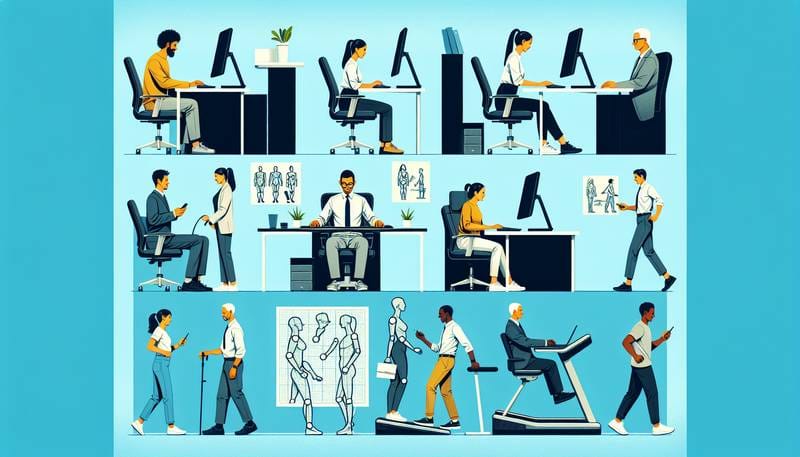The Complete Guide to Ergonomics in Tech Usage

Introduction: Why Ergonomics Matters in the Tech World
As the digital world envelops more of our lives, ergonomics in tech usage has morphed from a luxury into a necessity. It's easy to disregard the subtle aches that creep in after hours hunched over a keyboard, but these minor discomforts can snowball into long-term health issues. Whether you're a corporate titan managing empires from your office, a digital nomad hopping from coffee shop to couch, or a gaming enthusiast conquering virtual worlds, ergonomic practices are pivotal for maintaining your health, well-being, and productivity. This guide will dive into the intricacies of ergonomics in tech presence and offer tangible strategies for cultivating a workspace that harmonizes with your body's needs.
Understanding Ergonomics: More Than Just Comfort
Ergonomics transcends the realm of mere comfort; it's a discipline that intertwines design, function, and human physiology into a symphonic whole. When we reference ergonomics in the technology sphere, we talk about optimizing our interactions with electronic devices to augment efficiency and preempt potential injuries. This synergy is cultivated through meticulous tweaks to our equipment positioning, work habits, and the environment itself, all tailored to our body's demands. By embracing proper ergonomics, you're not only investing in your comfort but also nurturing your long-term health.
The Risks of Poor Ergonomics: Aches, Pains, and Long-Term Injuries
The perils of ignoring ergonomic principles aren't immediately apparent, often manifesting insidiously as minor twinges before escalating to debilitating conditions. Poor ergonomics, especially in the realm of technology, invites a cavalry of musculoskeletal disorders such as carpal tunnel syndrome, characterized by a tingling sensation and weakness in the hands and wrists due to nerve compression. Equally notorious is the threat of chronic back pain, often the result of suboptimal chair and screen heights coaxing the spine into unnatural curvatures. Let's not forget eye strain from glaring at screens without proper lighting or positioning, a silent thief of visual comfort. These issues, if unaddressed, can evolve into formidable adversaries, thwarting your ability to work effectively and enjoy a pain-free life.
Creating an Ergonomic Workspace: Tips and Tricks
Carving out an ergonomic sanctuary for your tech ventures doesn't require a herculean effort; a few focused adjustments can yield a monumental difference. Begin by evaluating your chair; it should not only be comfortable but also offer comprehensive support to your spine's natural S-curve. Adjust your chair so that your feet are flat on the floor or on a footrest, and your thighs are parallel to the ground. The height of your monitor is equally crucial; place it such that the top line of the screen is at or slightly below eye level to discourage neck strain. Position your keyboard to enable a slight downward, relaxed slope of your arms, thereby minimizing wrist pressure. And don't overlook the importance of breaks; getting up, stretching, and refocusing your eyes away from the screen at regular intervals can significantly lessen the strain from prolonged sitting and focus.
The Role of Tech Gadgets: How to Choose Ergonomic Accessories
In the quest for ergonomic perfection, the tools we use play a starring role. Keyboards with a gentle slope or a split design can alleviate the strain on your wrists, allowing them to rest in a more natural position. Opt for a mouse that contours to the crevices of your palm, minimizing the grip strength required and thereby reducing the risk of repetitive strain injuries. Monitor stands, laptop risers, and even desk pads can play unsung heroes in your ergonomic odyssey, keeping your gadgets at the ideal height and angle. When selecting these accessories, prioritize personal comfort and adjustability—your future self will thank you.
Beyond the Desk: Ergonomics for Mobile and Remote Workers
Ergonomics doesn't confine itself to the four walls of a traditional office space; it roams free, extending its reach to wherever your work takes you. Mobile and remote workers face unique challenges, contending with changing environments and often less-than-ideal conditions for tech usage. For the laptop-toting nomads, invest in a portable stand and an external keyboard and mouse to mimic the setup of a stationary workspace. Be mindful of the angle at which you view your device—aim for the same monitor eye-level guidance as you would at a desk. If you find yourself on your phone frequently, consider voice-to-text features or a phone stand to minimize the constant craning of your neck. Embracing flexibility and adaptability in your ergonomic adjustments is crucial for staying pain-free on the go.
Ergonomics for Everyone: Adapting to Different Needs and Abilities
No two bodies are the same, and ergonomics is not a discipline of absolutes but of personalized approaches. What constitutes comfort and efficiency for one person might not yield the same results for another. This diversity necessitates a deep dive into the world of custom ergonomics where adjustable gear becomes invaluable. Take for instance the adjustable desk that enables you to alternate between sitting and standing, thereby catering to diverse height requirements and body types. Consider ergonomic products with certifications like BIFMA or ADA compliance, which ensure a certain standard is met for a range of body shapes and sizes. For individuals with disabilities, ergonomic tech sees even greater importance. Adaptive keyboards, touchpad software that can interpret eye movement, and speech recognition technology are just the tip of the iceberg when it comes to making tech usage accessible and pain-free for all.
Conclusion: Making Ergonomics a Habit for Healthy Tech Usage
Ergonomic practices sprout from a seed of awareness and grow into a tree of habituation. We veer into the dangerous territory when we initiate changes with fervor only to slowly revert to our old ways as time wears on. To truly reap the benefits of ergonomics, we must engrain these practices into the fabric of our routine—make them our default rather than an afterthought. This means consistently arranging our workstations with care, selecting our tools with discernment, and taking regular breaks to restore our bodies and minds. It entails listening to the whispers of strain in our bodies and acknowledging the need for change. The journey to ergonomic tech usage is not a sprint but a marathon, one where the finish line is a lifetime of healthier work and leisure with technology.
Let us embrace ergonomics in our tech-laden lives with the vigor of champions. By doing so, we not only enhance our present work experience but also bolster our future health and well-being. Here's to excellent posture, comfortable gadgets, and an ache-free existence in the world of technology!


